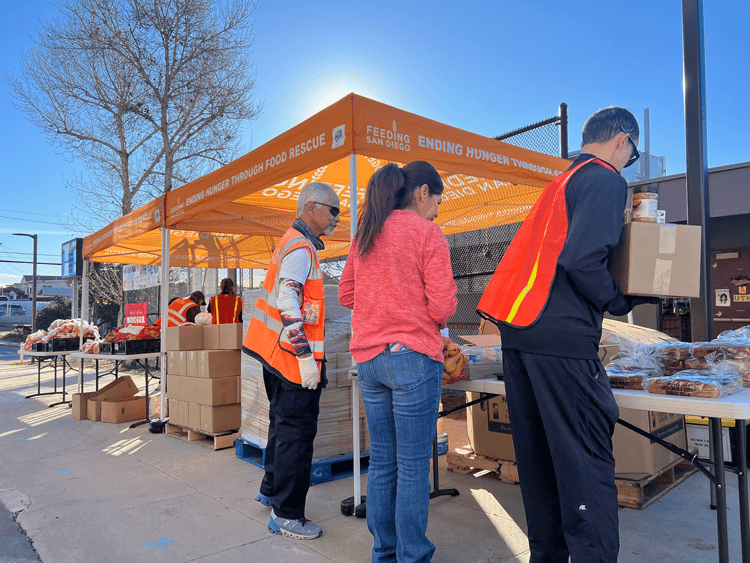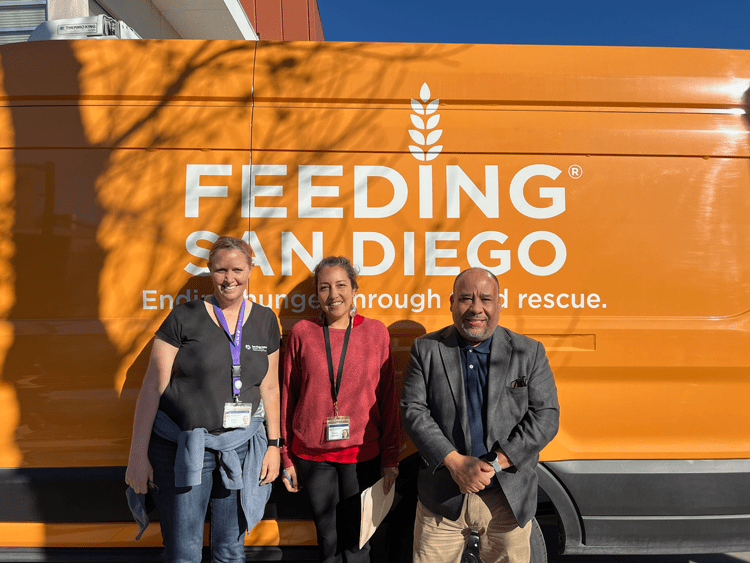Feeding San Diego’s Emergency Flood Response
On Monday, January 22, as much rain fell in San Diego in just six hours as it normally would in three months. This torrential rainfall caused devastation in our county that hadn’t been seen in decades. Homes and roads flooded. Cars were carried by water miles away from where they were parked. People and pets had to be rescued. Some families lost everything. The unexpected natural disaster displaced our neighbors, and many are now in need of resources. In the hardest hit areas, especially Spring Valley, Southeast San Diego, and National City, Feeding San Diego is activating its emergency flood response to provide ready-to-eat food and produce. This food is reaching families who are grappling with the reality of the damage caused by the storm.
Critical Support for Schools
Our direct services team first connected with local schools in impacted areas the week of January 22. As educators scrambled to support families, they quickly realized they would need additional resources. All this while many schools in La Mesa-Spring Valley School District and San Diego Unified experienced flooding on their campuses that forced them to relocate students. Emergency food distributions have since been in demand to provide easy-to-eat foods for students and their families in need of relief.
An emergency food distribution at Balboa Elementary
At Balboa Elementary in Southcrest, we met Kristy Drake, resource teacher at the Office of Children and Youth in Transition with San Diego Unified School District. Her team has been working nonstop since the storm and called Feeding San Diego to set up a pantry on campus.
“We are going out to sites to offer support and see what is needed, get kids clothes. They were coming to school with muddy shoes, muddy clothes,” she told us. “We’ve processed something like 60-70 families already who have nowhere else to go. Food has been huge because they also lost all of their food. They can’t really cook. You can’t eat out. If you have a family of four kids to eat out is an astronomical amount of money. Food has been the number one request and the number one need.”
Lack of Resources
At Balboa Elementary, their campus was badly damaged. Classrooms flooded, as did the auditorium. Four to six classrooms had ceiling tiles that deteriorated. In the kindergarten wing, water went into the classrooms because it’s on a slope. The school lost power during the storm.
“We haven’t seen a coordinated response. There’s the Red Cross that is sheltering. But as far as what happens to all of these families who are renting, where do they go? What’s the plan for them? We can’t find any coordinated response,” Drake says. “We’re just trying to band-aid the time, hoping that someone will come and coordinate a response.”
From left to right: Kristy Drake, resource teacher at the Office of Children and Youth in Transition; Patti Mejorado, school counselor at Balboa Elementary; and Hector Bravo, principal of Balboa Elementary
While immediate emergency response is critical, so is a plan for the long term. Educators can’t help but worry about the implications of the flooding on families over time.
“My biggest worry is what some of these kids have been exposed to, and when are they going to see symptoms? The water, the sewer, the gasoline. You name it. Everything is there,” says Hector Bravo, principal of Balboa Elementary. “A crisis of this magnitude just revealed how inadequate the whole system is supporting critical groups like us, schools.”
Devastating Losses
Balboa Elementary staff is seeing families in crisis, and this is only the beginning. Principal Hector Bravo confirmed that the number of families experiencing homelessness has more than doubled since the storm hit. The school has a significant refugee population and is about 80% Latino, with a high number of undocumented families.
“In Southcrest, there are a lot of renters here. When the landlord is trying to get the insurance claim going, the families can’t enter the house. They’re displaced, staying on floors in other family member’s houses,” Drake tells us. “Those that have been allowed to get back in are really staying in unsanitary conditions trying to clean up stuff. Some families are in their cars. Some families lost their cars, so they lost their dwelling and their transpiration all at once.”
A Long Road Ahead
Feeding San Diego has continued to receive requests from its network of food distribution partners since the storm. In addition to providing additional food to existing partners, we have also provided food to sites that we are not partnered with, like La Mesa-Spring Valley School District.
While school distributions are closed to the public, our emergency response team recognized the need to do more that’s open to the public and has arranged for several large-scale drive-through food distributions in the weeks ahead. A drive-through food distribution for 750 households will be held at Faith Chapel in Spring Valley on Monday, February 5, from 10 a.m. to 12 p.m. There will also be a distribution for 1,200 households at Southwestern College on Friday, February 10.
Your Support Matters
Please consider donating today to support our efforts in delivering ready-to-eat and instant foods, plus fresh produce, to San Diegans impacted by the floods. Your generous donation will significantly impact these flood victims’ lives and nourish those who have lost so much. Donations of cleaning supplies, clothing, and food for San Diego Unified are also welcome at the Office of Children and Youth in Transition.










